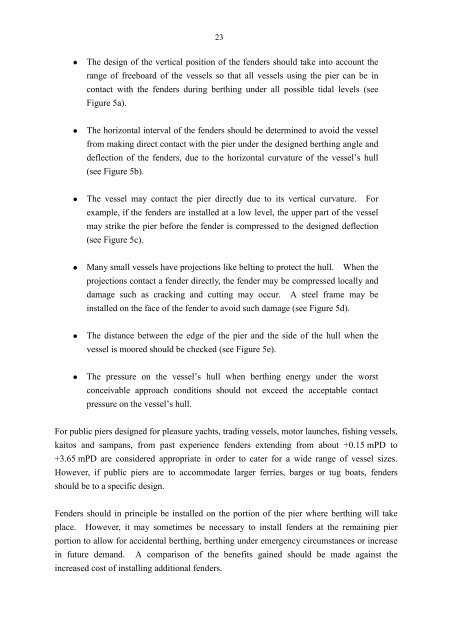Port Works Design Manual : Part 2
Port Works Design Manual : Part 2
Port Works Design Manual : Part 2
- No tags were found...
Create successful ePaper yourself
Turn your PDF publications into a flip-book with our unique Google optimized e-Paper software.
23• The design of the vertical position of the fenders should take into account therange of freeboard of the vessels so that all vessels using the pier can be incontact with the fenders during berthing under all possible tidal levels (seeFigure 5a).• The horizontal interval of the fenders should be determined to avoid the vesselfrom making direct contact with the pier under the designed berthing angle anddeflection of the fenders, due to the horizontal curvature of the vessel’s hull(see Figure 5b).• The vessel may contact the pier directly due to its vertical curvature. Forexample, if the fenders are installed at a low level, the upper part of the vesselmay strike the pier before the fender is compressed to the designed deflection(see Figure 5c).• Many small vessels have projections like belting to protect the hull. When theprojections contact a fender directly, the fender may be compressed locally anddamage such as cracking and cutting may occur. A steel frame may beinstalled on the face of the fender to avoid such damage (see Figure 5d).• The distance between the edge of the pier and the side of the hull when thevessel is moored should be checked (see Figure 5e).• The pressure on the vessel’s hull when berthing energy under the worstconceivable approach conditions should not exceed the acceptable contactpressure on the vessel’s hull.For public piers designed for pleasure yachts, trading vessels, motor launches, fishing vessels,kaitos and sampans, from past experience fenders extending from about +0.15 mPD to+3.65 mPD are considered appropriate in order to cater for a wide range of vessel sizes.However, if public piers are to accommodate larger ferries, barges or tug boats, fendersshould be to a specific design.Fenders should in principle be installed on the portion of the pier where berthing will takeplace. However, it may sometimes be necessary to install fenders at the remaining pierportion to allow for accidental berthing, berthing under emergency circumstances or increasein future demand. A comparison of the benefits gained should be made against theincreased cost of installing additional fenders.
















